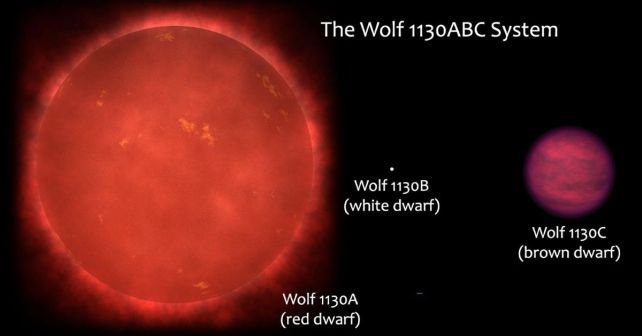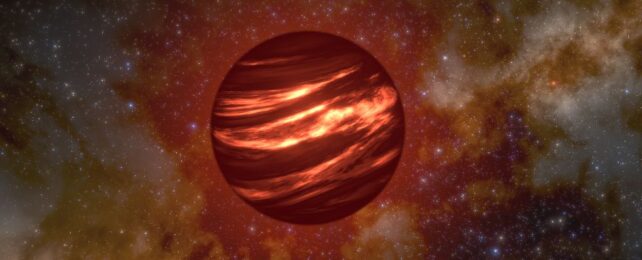A detection of phosphine in the atmosphere of a brown dwarf 54 light-years from Earth deepens the mystery of phosphorus chemistry throughout the Milky Way.
An ancient object more than 10 billion years old, Wolf 1130C has phosphine at an abundance of about 100 parts per billion, a team led by astrophysicist Adam Burgasser of the University of California, San Diego has discovered.
It's the first and so far only clear detection of phosphine (PH3) in a brown dwarf. The abundance is consistent with what models predict, but this presents a problem: PH3's absence in other brown dwarfs.
This means there might be something missing in our understanding of phosphorus chemistry, throwing PH3's status as a potential biosignature into disarray. The finding reinforces that PH3's role as a potential sign of life must be treated cautiously, as it can arise in multiple non-biological environments.
Related: That Scandalous Phosphine on Venus Really Could Come From Volcanoes, Says New Study
"Ironically, Wolf 1130C isn't the problem – it's all the other brown dwarfs and giant exoplanets! PH3 is the expected molecular form of phosphorus in the low-temperature, hydrogen-rich atmospheres of giant planets and brown dwarfs based on our current understanding of dynamic chemistry in these atmospheres," Burgasser told ScienceAlert.
"But despite many efforts using ground-based telescopes and JWST, this is the first time we've detected this molecule in a brown dwarf or giant planet outside the Solar System at its predicted abundance. So whatever chemical processes that form or inhibit the formation of this molecule are not universal; Wolf 1130C shows us that PH3 chemistry varies from source to source, which is not what we expect from our current understanding of atmosphere chemistry."
PH3 had a bit of a moment back in 2020, when scientists announced that they had detected it in the atmosphere of Venus. Here on Earth, PH3 is mainly produced by microbes.
For this reason, astrobiologists consider PH3 a potential biosignature, a signal that may indicate the presence of life. However, there are other, non-biological extraterrestrial contexts in which PH3 appears. It's found in significant quantities in the atmospheres of Jupiter and Saturn, for example. It forms in their hot, high-pressure bellies and is borne aloft via convection.
It's from these two gas giants that scientists have built atmospheric chemistry models for other gas giants and brown dwarfs. These models mostly work well for molecules such as ammonia, carbon dioxide, and methane.
"But there seems to be a strange inconsistency with phosphorus chemistry, in that our model works for Jupiter, Saturn, and now Wolf 1130C, but not other brown dwarfs and exoplanets studied to date," Burgasser explained. "It's definitely a puzzle!"

Brown dwarf stars bridge the gap between gas giant planets and small stars. As such, they are important laboratories for studying both.
The researchers turned JWST to Wolf 1130C, taking spectral observations in infrared light to look for the telltale shadows introduced by PH3 as it absorbs light in specific wavelengths. It didn't take long to find.
"It was a surprise just how obvious the feature was when we first acquired the data," Burgasser said. "Studies to date have had to undertake challenging analyses to search for bare traces of this molecule, but for Wolf 1130C, it was visually apparent even in our lowest resolution data."
The abundance of PH3 in the atmosphere of Wolf 1130C is similar to the abundances seen in Jupiter and Saturn, aligning neatly with atmospheric models. It's the first time astronomers have looked at the atmosphere of a brown dwarf and found the amount of PH3 they expect to see there, raising large questions.

"We have some possible clues as to why Wolf 1130C stands out in this respect. It has a lower abundance of all elements beyond hydrogen and helium, and it may be that the change in elemental abundances modifies the usual modes of phosphorus chemistry," Burgasser explained.
"In addition, Wolf 1130C is part of a triple system that includes a massive white dwarf, which itself may be a source of phosphorus, elevating this element's abundance among its companions."
Getting to the bottom of this mystery will involve further study. Researchers are trying to come up with an atmospheric model that can explain why only one, out of all the brown dwarfs sampled to date, has the expected abundance of PH3. Scientists also need to narrow down the conditions in which PH3 can exist.
There is also, Burgasser noted, the issue of figuring out where the oddity lies: is Wolf 1130C the oddball, or is it all the other brown dwarfs out there?
"By approaching this mystery from multiple perspectives, we will have a better understanding of how this important element emerged in our galaxy and whether it can be effectively used to search for life on other worlds," he said.
Until this puzzle is solved, the researchers caution, scientists should steer away from using this strange molecule as a sign of life on alien worlds.
The research has been published in Science.
